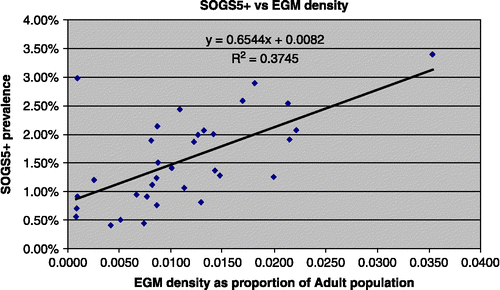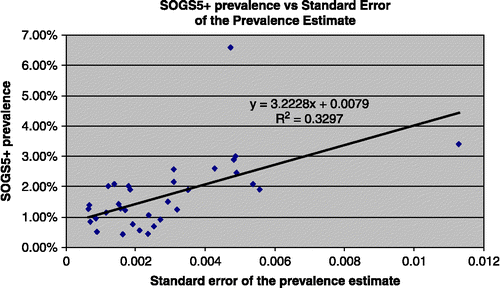Abstract
It is widely believed that greater availability of electronic gaming machines (EGMs) has led to increases in problem gambling prevalence and related harms. It has also been proposed that individuals and populations adapt to exposure over time and that prevalence rates plateau or decline, even in the face of increasing availability. This study examines both hypotheses using a combined data set of 34 problem gambling surveys conducted in Australia and New Zealand since 1991. Strong statistically meaningful relationships were found for an increase in prevalence with increasing per capita density of EGMs, consistent with the access hypothesis and supported by no evidence of plateauing of prevalence with increasing density of EGMs. A decrease in prevalence over time with availability held constant is also evident, partially consistent with adaptation. It is likely that both forces are at work simultaneously, with implications for appropriate policy responses to gambling harm minimisation.
Introduction
Over the past 20 years there has been a rapid increase in the availability of electronic gaming machines (EGMs) in New Zealand (NZ) and Australia. EGMs were first licensed in NZ in 1988 and reached a peak of 25,221 in 2003 (Department of Internal Affairs, Citation2007a). At the end of 2006 there were 20,163 machines in the country (Department of Internal Affairs, Citation2007a). In 1999 there were an estimated 183,506 EGMs in Australia (Office of Economic and Statistical Research, Citation2007). By 2006 the number had risen to 200,850 with just under half of these in New South Wales (NSW) (Office of Economic and Statistical Research, Citation2007). In both countries the majority of EGMs are widely distributed in clubs and pubs. There are also significant numbers in casinos. In the case of Western Australia (WA), EGMs are exclusively located in that state's sole casino, situated in Perth, the major city.
Gambling is a significant industry in both countries. In 2005–2006 gambling accounted for 2.9% of household disposable income in Australia (Office of Economic and Statistical Research, Citation2007). Sixty per cent of the total gambling expenditure of Au$17.6 billion was on EGMs (Office of Economic and Statistical Research, Citation2007). In NZ, in 2006–2007, 50% of the total NZ$2.0 billion spent on gambling was on EGMs (Department of Internal Affairs, Citation2007b).
At the same time there may be a cost to the community associated with increased access to gambling. It is widely believed that greater gambling availability, particularly of continuous forms including EGMs, track and sports betting and casino table games, has lead to an increase in gambling participation and a variety of gambling-related problems including pathological and less severe forms of problem gambling (Productivity Commission, Citation1999; Shaffer, Hall & Vander Bilt, Citation1997). Both major reviews (e.g. Abbott & Volberg, Citation1999; Raylu & Oei, Citation2002; Shaffer et al., Citation1997) and official national inquiries in various countries (Gambling Review Body, Citation2001; National Research Council, Citation1999; Productivity Commission, Citation1999) have, with varying degrees of qualification, concluded that research findings are consistent with this assessment. EGMs are frequently claimed to be the gambling form most strongly implicated in the development of problem gambling (Dowling, Smith & Thomas, Citation2005). In NZ and Australia, the great majority of people seeking formal specialist help for gambling problems report problems exclusively or predominantly with EGMs (Abbott, Citation2006), with associated social and economic costs to the individual, their families and society (Productivity Commission, Citation1999).
The Australian Productivity Commission (1999, p. 8.1), based on an extensive literature review and primary research stated, “While causation is hard to prove beyond all doubt, there is sufficient evidence from many different sources to suggest a significant connection between greater accessibility – particularly to gaming machines – and the greater prevalence of problem gambling.” It further noted that “Determination of the nature of the relationship between the availability of EGMs and gambling-related problems is of central importance to public policy, including “government measures aimed at ameliorating problem gambling” (Productivity Commission, Citation1999, p. 6.2).
While the public policy implications of the relationship between the prevalence of problem gambling and access to gambling, particularly access to EGMs, are significant and of importance to policy-makers, there is little sound empirical data to inform conjecture regarding such relationships. What data do exist are limited in application or interpretation because of large relative sampling errors, lack of statistical significance arising from small numbers of data points in determining trends or, finally, by the use of proxies for access to gambling.
Accordingly this paper seeks to empirically examine the relationship between density of electronic gaming machines, the passage of time and the prevalence of problem gambling by compiling and analysing a large data set. Those relationships are then examined in the context of the hypotheses of ‘access’ and ‘adaptation’ in order to inform appropriate policy responses to gambling harm minimisation. The paper uses direct measures of both the prevalence of problem gambling and availability of EGMs.
If access is a primary factor in increasing problem gambling prevalence, then a policy focus on limiting availability would be appropriate. If not, an emphasis on other forms of harm minimisation such as education and early intervention might be more appropriate. This is the central concern of this paper.
Previous research
Shaffer et al. (Citation1997) carried out a meta-analysis of 120 studies of problem gambling prevalence conducted in North America. Apart from providing a wide-ranging justification for the use of meta-analysis and articulation of the various philosophical debates surrounding the measurement of problem gambling prevalence, they tested five hypotheses. Of these, two are of direct relevance to the current paper. These were that “The increased access and exposure to gambling opportunities of the past 23 years will be reflected in an increase in prevalence of gambling and the problems and disorders associated with this activity” and that “The instruments used to generate prevalence estimates will influence the rate of observed gambling problems” (Shaffer et al., Citation1997).
With respect to the first hypothesis, Shaffer et al. found a statistically meaningful link between time and the measured prevalence of problem gambling (R 2 = 0.20, p < 0.01).Footnote1 While meaningful, this finding leaves much of the variation unexplained. The methodology also has some shortcomings including the use of time as a proxy for access to gambling opportunities with a corresponding range of concerns regarding collinearity and variation in sampling methods. With respect to the second hypothesis, they found that “Disordered gambling is an apparently robust phenomenon that research can identify reliably across a wide range of investigative procedures that vary in quality of method”. This finding supports the meta-analysis approach taken in the present paper insofar as this study combines data sourced using similar investigative techniques but varying in methodological quality and detail.
The Productivity Commission (Citation1999) carried out a comprehensive survey of the prevalence of problem gambling across the eight states and territories of Australia. In the Commission's report, a number of linear regression analyses are presented. These generally show a trend between various indicators of the intensity of gambling and the prevalence of problem gambling. While R 2 values are reported, no p values are given. Analysis carried out by Storer (Citation2007) on these data sets found that the p values are such that the null hypothesis (that the relationship does not exist) should not be rejected at the 95% level of confidence.
While most reviewers and official gambling inquiries conclude that increased exposure to continuous forms of gambling, including EGMs, has led to a rise in prevalence, others (Abbott, Citation2006, Citation2007; Abbott, Volberg, Bellringer & Reith, Citation2004a; Shaffer, LaBrie & LaPlante, Citation2004) maintain that relationships between availability and problems are complex and that consideration needs to be given to the duration of exposure as well as to individual and wider environmental factors that moderate exposure effects. They propose that in particular circumstances the relationship between rising exposure and escalating problems breaks down. This adaptation process is thought to involve increased awareness of problem gambling, development of informal social controls, expansion of treatment and mutual-help and regulatory changes.
Abbott (Citation2001a, Citation2006, Citation2007) challenged the Productivity Commission assertion of a linear relationship between EGM density and problem gambling in Australian jurisdictions. From visual inspection of the data presented he suggested that while jurisdictions with very low densities had lower prevalence rates than those with high densities, beyond a particular density further increases did not appear to be associated with increased problems. Storer (Citation2007) undertook an independent statistical analysis of this data set to assess both linear and, as proposed by Abbott, non-linear relationships. He found that neither the linear hypothesis nor the hypotheses put forward by Abbott were supported by the data.Footnote2 This latter conclusion is also supported in previous work using expenditure on EGMs as a proxy for prevalence of problem gambling (Storer & Stubbs, Citation2007; Stubbs & Storer, Citation2003).
Both the Shaffer et al. (Citation1997) meta-analysis and Productivity Commission national survey examined problem gambling prevalence across multiple jurisdictions. Another way to assess the availability and adaptation hypotheses is to consider change over time in single jurisdictions where more than one prevalence study has been conducted. This now includes New Zealand and all Australian jurisdictions. These studies vary in the methodologies employed and sample size. This makes it difficult to determine whether change, or its absence, is real, a result of methodological differences or simply a result of sampling error.
Regardless of possible methodological differences, sampling error is likely to be a major source of variance in estimates of problem gambling prevalence. The various studies are shown graphically in Figures with error bars estimated on the 95% confidence interval for sampling error.Footnote3 The considerable size of the error bars should be noted.
Almost universally in the various studies from which the data are derived, estimates of prevalence are represented as point estimates with attendant interpretative problems. Statements regarding trends based on a point estimate are unlikely to be statistically significant given the range of sampling error. While difficult to identify a clear overall trend, from visual examination of the figures it appears that there has been no evidence of change over time in NT, ACT and WA (Figures 2, 3 and 9); jurisdictions for which there are only two estimates each. In NSW (Figure 1) the data suggest that following a period of no change during the mid 1990s, prevalence decreased between 1999 and 2006. Qld and SA (Figures 5 and 6) show no clear trend with time with a number of interpretations possible. In the case of Tasmania and Victoria (Figures 7 and 8) increases appear to be followed by prevalence reductions. In NZ (Figure 4) there appears to have been a reduction in prevalence that was sustained during the mid to late 1990s, followed by a more recent increase.
Linear regression analysis can be used to quantify these apparent trends in the data, however the statistical relevance of such an analysis will be small because of the small number of data points. The analysis is further confounded by the heteroskedasticity inherent in the varying error bars and arising from different sample sizes.
As well, methodological and other variations between studies within jurisdictions may complicate interpretation. For example, in NZ, while the first three studies used broadly similar methodologies including telephone interviewing and the South Oaks Gambling Screen – Revised (SOGS-R) to measure problem gambling, the latest survey embedded a different problem gambling measure, the Problem Gambling Severity Index (PGSI) within a general health survey involving door knock recruitment and face-to-face interviews.
Methodology
General
There are two major problems with forming conclusions about the relationship between the prevalence of problem gambling and other environmental factors. The first lies with the measurement errors inherent in the binomial distribution and the second lies in the difficulty in obtaining data points.
In the case of the first, typically the prevalence of problem gambling in a population is quite low. Adopting typical values of 1.5% prevalence (however measured) and a sample of 2000 respondents, the standard error is calculated as ± 0.3% with a 95% confidence interval of ± 0.5%, or one third of the measured prevalence. Hence detecting statistically significant trends can be difficult, even with large samples. Large numbers of data points may be required to analyse variance arising from sampling error and hence detect underlying trends.
In relation to difficulty obtaining data, there are a limited number of data points available and the cost of obtaining additional data points is significant. For good results with regard to hypothesis testing, most authorities suggest 30 or more samples are required (Walpole, Citation1974, p. 159).Footnote4 Other authorities are more cautious suggesting 50 or more samples (Hill, Griffiths & Judge, Citation2001). To minimise variation and ensure consistent methods and a constant social environment it would be ideal to sample 30 or more different areas within a particular jurisdiction at a particular time. Because of the low prevalence of problem gambling and the effects of the binomial distribution, large samples are required. To determine time trends, a number of such studies would be required. An alternative approach is to use a meta-analysis combining data from a number of separate analyses.
Method
The primary method used was to assemble an aggregated data set and then analyse that data set using linear regression analysis. Data assembled included problem gambling prevalence, jurisdiction, year, adult population, number of EGMs and sample size. A number of multi-variate linear regression analyses were then carried out on the data set using the SHAZAM econometric software package with adjustment for heteroskedasticity where appropriate.
All available studies were included in the analysis. A total of 34 surveys of the prevalence of problem gambling were identified across Australia and New Zealand. Of these, six used the PGSI and the remaining 28 used the SOGS-R. Sample size varied widely, ranging from 258 to over 30,000, with a range of survey methods use. A SOGS score of five or more was selected as indicating problem gambling. This followed the approach adopted by the Productivity Commission and used by many Australian studies. For those surveys using the PGSI, PGSI scores were converted to SOGS5+scores. The basis of conversion was the 2005 Tasmanian study of 6048 people, which administered both instruments to regular gamblers. In this study, 92% of those rated as problem gambling, 22% of those rated as moderate risk and 8% of those rated as low risk on the PGSI rated as SOGS5+.
Of the 34 studies, the 1991 capital cities study and the 1996 Tasmanian studies were excluded. The 1991 capital cities study was spread across jurisdictions and so population and EGM numbers were not readily available, precluding use. As a secondary point, the value itself suggests the possibility of gross error or significant difference in methods being four times average values and well outside the values found in any other study. The 1996 Tasmanian measure of problem gambling prevalence was associated with a large residual in the regression analysis. As shown in Figure , this estimate is three times the value of samples for 1994, 1999 and 2000. An examination of gambling expenditure in Tasmania for the period 1994–2000 shows a steady increase in real per-capita gambling expenditure over time with no evidence of any peak associated with 1996 (Office of Economic and Statistical Research, Citation2007). Abbott (Citation2001b) also raises a number of concerns with this study (see also Abbott & Volberg, Citation1999).
Figure 1 Surveys of problem gambling prevalence – NSW data.Note: PGSI scores have been transformed to SOGS5+scores. Source: Refer to Table 1 for data sources.
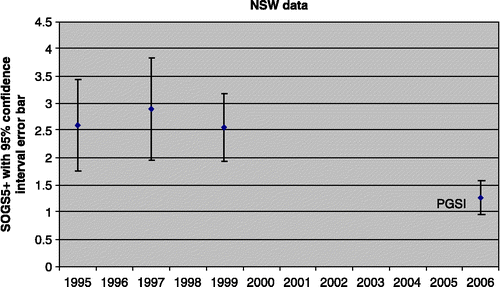
Figure 2 Surveys of problem gambling prevalence – NT data.Source: Refer to Table 1 for data sources.
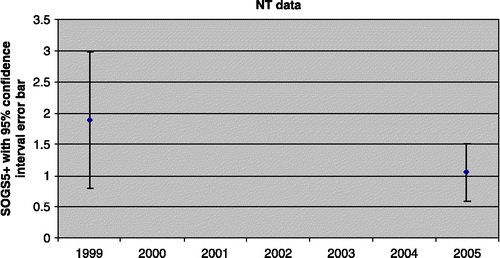
Figure 3 Surveys of problem gambling prevalence – ACT data.Source: Refer to Table 1 for data sources.
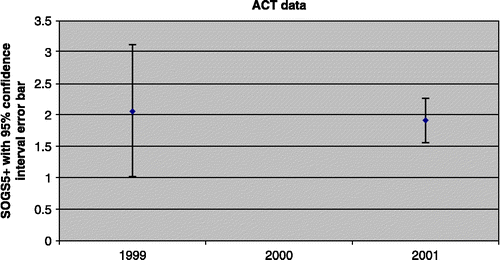
Figure 4 Surveys of problem gambling prevalence – NZ data.Note: PGSI scores have been transformed to SOGS5+scores.Source: Refer to Table 1 for data sources.
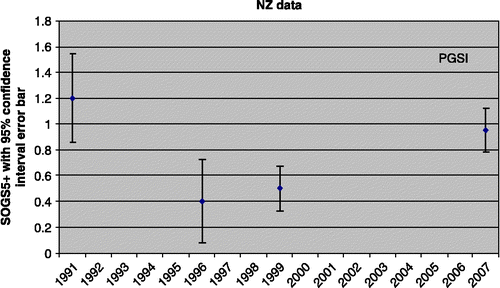
Figure 5 Surveys of problem gambling prevalence – QLD data.Note: PGSI scores have been transformed to SOGS5+scores.Source: Refer to Table 1 for data sources.
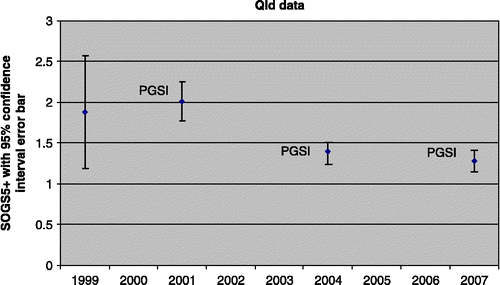
Figure 6 Surveys of problem gambling prevalence – SA data.Note: PGSI scores have been transformed to SOGS5+scores.Source: Refer to Table 1 for data sources.
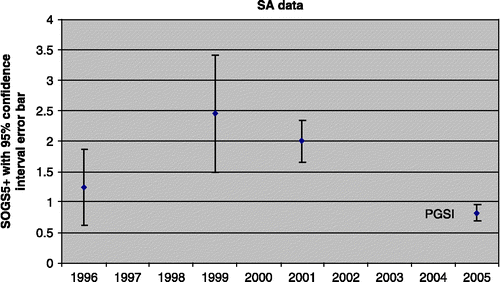
Figure 7 Surveys of problem gambling prevalence – Tasmanian data.Source: Refer to Table 1 for data sources.
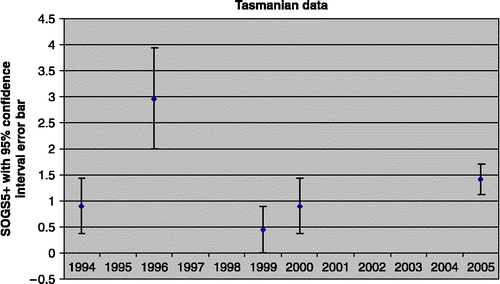
With regard to the combination of Australian and NZ data, the approach taken was that the relative standard errors arising from sampling were likely to be of much greater magnitude than errors arising from other variations between jurisdictions and in methods used by different surveyors. The size of the relative standard errors is evident from Figures . For example, the 1995 NSW result has a relative standard error of two thirds of the estimate. The larger the number of samples in the analysis, the more likely the measured variance will approach the true value and the less likely the analysis will be affected by a single outlying result.
Figure 8 Surveys of problem gambling prevalence – Victorian data.Source: Refer to Table 1 for data sources.
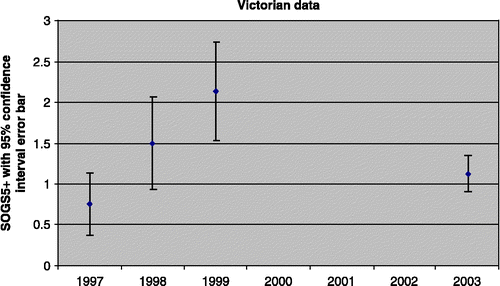
Figure 9 Surveys of problem gambling prevalence – WA data.Source: Refer to Table 1 for data sources.

The combined Australian PC data was also included. There are two views. The first is that the same data is in the analysis twice. The second is that it represents an additional data point. Based on analysis of gaming data over a number of years around EGM density and per capita expenditure on EGMs for NSW, there is an enduring relationship between the two variables (Storer & Stubbs, Citation2007). More importantly, the relationship is persistent across a range of geographic scales. The more data points, the better the estimate of variance within the model and so the better the results in terms of both results and confidence in those results. Exclusion of the value for Australia in the regression analysis returned essentially the same coefficients, but with a deterioration in tests of parameter significance.
The year, sample size and jurisdiction of the survey were obtained from the various reports of the surveys and in some cases from secondary sources. Adult population was taken from census records with inter-censal years obtained by linear interpolation. The number of EGMs in each jurisdiction for each year was obtained from various government agencies or from Australian Gambling Statistics.
The data set, with reference to sources, is shown in Table .
Table 1. Combined data set.
Methodological issues related to the data set
The immediate question must be the legitimacy of combining data from a range of sources. There are three major sources of error in this approach with error arising from variation in sample size, variations in method of measurement and variations between jurisdictions. The relative sampling error varies between data points, that is some data points are more reliable than others, but the method of analysis takes no account of this, treating the variation in sample size as random, however any systematic variation of sample size will need to be accounted for. In relation to the method of measurement, a range of issues around methods used for the measurement of prevalence of problem gambling are evident, including choice of instrument and method of administration. For a discussion of many of these matters, see Abbott (Citation2006) and Abbott and Volberg (Citation1999). The approach taken in this paper assumes that the various surveys are part of a family of methods but with some variations in approach. It is assumed that these variations are random, that is that there are a limited number of variations and that the various practitioners choose randomly from these variations and that these errors are relatively inconsequential compared with the large errors arising from sampling.
In terms of the third source of errors, variation across jurisdictions, there are three components. The first is spatial distribution, the second is variation in social indicators such as wealth and education and the third could be termed trajectory. Spatial distribution is most likely to be significant. There is significant variation in gambling behaviour across NSW when examined at the LGA level and there is a strong and enduring correlation between the density of EGMs and per capita expenditure on EGM gaming (Storer & Stubbs, Citation2007; Stubbs & Storer, Citation2003). This source of error has not been treated systematically but is likely to be significant. Social indicators are likely to be less variable. All jurisdictions are culturally similar to some degree and the effect of variations in wealth has been avoided to some extent by adopting density of EGMs as an indicator of access to gambling rather than using expenditure. Jurisdictions may be on different trajectories with regard to time. As an example, NSW has a long history of access to EGMs but in other jurisdictions, proliferation has occurred more recently.
This paper adopts the view that there is more information to be gained from the combination of data from various sources as a result of the large errors associated with sampling error, compared with the additional variance introduced by variations between sampling size, sampling methods and jurisdictions. Any regression analysis has two components consisting of explained variation in the dependent variable and unexplained variation in the dependent variable. The explained variation in the model will consist of those variables analysed and found significant while the unexplained variation will lump together all the other sources of error. Thus the sources of variation discussed above, and including sampling error itself, will be found in the unexplained portion of the model.
Results
Preliminary analysis
A preliminary analysis was carried out to identify data trends and to confirm assumptions regarding both randomness of sample size with respect to time and prevalence; and uniformity of methods, particularly to identify data points suggestive of marked variation in methods or of gross error. Selected extracts from that analysis are shown graphically in Figures 10–13.
Figure shows a relationship between increasing density of EGMs and higher SOGS5+prevalence rate. The data seem reasonably clustered around the line of best fit, however the value of 2.97%, the 1996 value for Tasmania, seems anomalous. The 1991 capital cities data are not included for reasons discussed above. Variation in density of EGMs accounts for around 38% of the variation in SOGS5+prevalence.
Figure shows a weak relationship between increasing sample size and SOGS5+prevalence, however, that relationship is not statistically significant. Also evident is the increase in variance as sample size drops as would be expected from the sampling error of the binomial distribution.
Figure shows a statistically insignificant relationship between the prevalence of problem gambling and time. The trend is largely a result of the 1991 6.6% estimate. When this is removed from the data set, the relationship disappears and there is no apparent relationship.
Figure shows the relationship between the standard error of the prevalence estimate and the SOGS5+score. The relationship is an artefact of the calculation of the standard error. Of more interest is the distribution of values about the line of best fit. The 6.6% obtained for the 1991 four cities survey is well outside the range of variation and appears anomalous. This sample was omitted from the data set for reasons discussed above, with such an omission supported by this figure.
Results for the combined data set
Multivariate linear regression analysis was carried out for the combined data set. Cross correlation and heteroskedasticity were considered due to likelihood of collinearityFootnote5 between variables, and the likelihood of heteroskedasticityFootnote6 arising from any systematic variation of sample size with other variables. Analysis found collinearity was unlikely to be a problem given the generally low cross correlation coefficients.
A transformed variable; SAMP3 = (SAMPLE)–1/2; was used to check for any systematic variation of problem gambling with sample size and with other variables. A correlation was found with this variable and time suggesting heteroskedasticity should be expected.
A range of models incorporating heteroskedasticity and a number of tests of heteroskedasticity were investigated. The Goldfeld Quant test supported an assumption of inverse heteroskedasticity with respect to EGM density hence a generalised least squares model was used.
The data were analysed using SHAZAM function GLS assuming inverse heteroskedasticity with respect to the density of EGMs. Results are summarised below:
The prevalence of problem gambling increases with increasing density of EGMs. The 95% range for the coefficient is 62.3–101.7. Multiplying both sides of the equation by population, the coefficient predicts that each additional EGM introduced into an area will result in an increase of between 0.6 and 1.0 problem gamblers with an average of 0.8 problem gamblers per EGM.
Problem gambling prevalence is also found to decrease with time. The 95% range for the coefficient is − 0.14 to − 0.04, suggesting an annual decrease in problem gambling prevalence ranging between 0.14% and 0.04%, with an average decrease expected of 0.09%. This coefficient needs to be treated with caution with respect to extrapolation outside the range of data, as the model predicts that in the absence of EGMs (PERCAP = 0), the prevalence rate of problem gambling in years after 2007 is negative. Apart from the concept of negative prevalence of problem gambling being meaningless, it seems more likely that there would be an underlying prevalence of problem gambling, however the data set is not sufficiently long as to identify such a trend.
The hypothesis of a diminishing rate of increase of problem gambling with increase in density of EGMs was also tested by assuming a parabolic functional form for the relationship between problem gambling prevalence and density of EGMs by including the square of density as a variable. The data were ‘centred’ on the mean to minimise effects of collinearity. The point at which prevalence of problem gambling would decrease was calculated by simple algebra. This calculation suggested a limit to growth of problem gambling with additional EGMs at a level of 0.10 EGMs per person, well above the level found in any jurisdiction, however the results were not statistically significant, with p = 0.245 for the squared parameter.Footnote7 A range of non-linear relationships using various log and power transformations were also checked but no significant relationships were found.
Discussion
The foregoing analysis suggests some robust findings and some that appear to be more ambiguous, requiring further research. On the one hand the findings strongly indicate that the prevalence of problem gambling increases with increasing density of EGMs at a rate of around 0.8 problem gamblers for each additional EGM. Further, there is no evidence of plateauing of problem gambling prevalence with increasing density of EGMs. These findings corroborate an access thesis,Footnote8 with the latter finding suggesting that the access thesis holds across at least the range of EGM densities considered in this study.
On the other hand, problem gambling prevalence is found to decrease with time, ceteris paribus, which would partially support a thesis of individual or community adaptation. An average annual decrease in prevalence of 0.09% is expected where there is no change in EGM density. However, the prediction that prevalence will reach a limit or even decrease in the face of increasing access to EGMs (a plateauing effect) under a process of adaptation (Abbott, Citation2006, Citation2007) is not supported. Thus, while there is corroboration of the access thesis, the question of adaptation appears to be more complex.
Finally, the finding of apparent inverse heteroskedasticity with respect to EGM density is of note, where areas with low EGM to population ratios appear to show greater variation in prevalence. The geographic clustering of EGMs in areas with otherwise low EGM to population ratios may account for some of this variance, with areas with high density clusters having higher average prevalence of problem gambling. This conclusion is supported by the findings of Storer and Stubbs (Citation2007).Footnote9
These findings have particular implications for public policy related to gambling harm minimisation in relation to availability of EGMs, concentrations of EGMs and the application of individual or community-focussed harm minimisation measures.
The findings support a view that restricting the per capita density of EGMs will lead to reduced gambling harm. Conversely, unrestricted increase in EGM numbers is highly likely to result in ongoing increases in gambling harm. Accordingly, the findings are consistent with policy approaches based on regional caps like those in Victoria (Department of Justice, Citation2006), and the recent amendments to the NSW Gaming Machines Act (New South Wales Government, Citation2001), which has put in place stronger controls around the increase in EGMs based on a consideration of density, expenditure and socio-economic disadvantage for local areas.
The apparent finding that there is greater variation in the prevalence of problem gambling in samples with lower per capita density of EGMs has implications for the clustering of venues in discrete geographic areas. As such, other aspects of availability, such as the number and location of licensed venues in particular localities and the number of machines per venue, may also warrant investigation to complement the geographic scale of our analysis. All EGMs may, for example, be clustered in one part of a local government area or state, and may have differential impacts. The nature of the particular venues may also play a role. The finding appears to support the community impact assessment process implemented in various jurisdictions that allow for a more fine grained analysis to understand the impacts of different scales and in relation to different types of venues (see for example ACT Government, Citation2004; NSW Government, Citation2001).
The question of the effectiveness of individual and community-focussed harm minimisation measures is less clear in light of the findings. Prevalence decrease can occur as a consequence of a reduction in incidence (fewer people developing problems) or problem duration (people overcome problems more rapidly or exit the population by migration or death). A variety of factors have been considered, at both individual and wider societal levels, that may influence incidence and problem duration (Abbott, Citation2006, Citation2007; Abbott et al., Citation2004a; Shaffer et al., Citation2004). For example, individual problem gamblers may modify their gambling behaviour over time through self (‘natural’) recovery or professional intervention (Abbott, Williams & Volberg, Citation2004b). Communities may gradually adjust to the novelty of additional gaming opportunities or develop increased awareness of the potential harm as well as recreational benefits of EGMs, and adopt less hazardous gambling patterns. A prospective community study found, over a seven-year period, that most regular gamblers either greatly reduced their frequency of participation or switched to other forms of gambling, predominantly lottery products (Abbott et al., Citation2004b).
Abbott's (Citation2006, Citation2007) modification to the exposure hypothesis specifies that populations are at particularly high risk for the development of problem gambling when exposed to new forms of gambling. Over time, it is hypothesised that adaptation (‘host’ immunity and protective environmental changes) occurs and problem levels reduce. It is further proposed that EGMs give rise to more transient problems than some other continuous gambling forms and that public health measures may accelerate adaptation.
The decrease in prevalence of problem gambling with time could also be explained by population adaptation by a form of ‘natural selection’, with unsuccessful individuals removed from the ‘pool’ of problem gamblers. Problem gambling may be difficult to sustain in the long term, with the career of problem gamblers limited by the extent to which their income and asset base can sustain their high rates of expenditure, or by other factors such as criminal charges arising from problem gambling behaviour, severe personal or financial crisis leading them to seek assistance, or in extreme cases, suicide (see for example Brown & Coventry, Citation1997; Crofts, Citation2002; Myer & Stadler, Citation1999). The career of the problem gambler may involuntarily end or they may ‘recover’, but the flow on effects to their family, associates and community may have long-term costs and consequences (Productivity Commission, Citation1999). It is debatable whether intervention following such serious outcomes could be termed harm minimisation.
Adaptation hypotheses predict plateauing of problem gambling prevalence with increasing density, and this trend is not evident. The difficulty of measuring changes in the prevalence of problem gambling is also worth noting. As such, it is likely to be quite difficult to measure the effects of particular harm minimisation approaches as the measures would need to have a significant effect on the prevalence of problem gambling to be detectable within the limits of sampling error.
These different aspects of ‘adaptation’ have differential consequences for individuals and communities, in the short and longer-term, and suggest quite different policy approaches. At one end on the spectrum, measures such as the expansion of social marketing and education programmes, early intervention and a range of treatment options would be beneficial where it is demonstrated that there are preventative benefits, or that problem gamblers readily respond to such measures prior to more widespread harm resulting. However, the more serious and longer-term aspects of ‘population’ adaptation indicate that stronger measures related to limiting or actively reducing density and/or geographic concentration of EGMs may be a more appropriate policy response.
The finding of decreased problem gambling prevalence over time is thus a complex matter with a range of possible explanations and consequent policy implications. The current study again raises questions that warrant more detailed explanations.
Given the complexity of the adaptation thesis noted above, a variety of research approaches are required to assess these various conjectures regarding its nature and implications. This may include longitudinal cohort studies that track non-problem and problem gamblers over time to identify first, if they develop or continue to display behaviours associated with problem gambling and second, what factors have led to apparently adaptive behaviour. These studies should also shed some light upon the effectiveness of more individually focussed harm minimisation measures.
Conclusion
The nature, degree and causes of harm related to EGMs have been the focus of considerable academic inquiry since the mid-nineties. This has been accompanied by speculation on the role of factors such as ‘access’ and ‘adaptation’ in exacerbating or mitigating harm. A range of policy measures introduced to address harm are in place in various jurisdictions, and are underpinned by implicit or explicit assumptions regarding the relative importance of such factors.
It is likely that both access and adaptation forces are at work simultaneously, with varying implications for policy. First, there is strong support from the present findings for the access thesis, with strong statistically meaningful relationships between an increase in problem gambling prevalence and increasing per capita density of EGMs, at an average increase of 0.8 problem gamblers for each new EGM. Further, there is no evidence of plateauing of prevalence with increasing density of EGMs, one of the predictions of the adaptation thesis. These findings indicate that policies related to restricting or reducing the density of EGMs are likely to play a significant role in containing or reducing gambling-related harms.
A further finding of increased variance in prevalence of problem gambling at low densities of EGMs may signal the importance of clustering of licensed venues and EGMs in particular localities, or variations in the nature of the venues themselves. This finding warrants more fine-grained analysis.
The finding of a decrease in prevalence of problem gamblers, at a rate of 0.09% per annum with EGM density held constant, is partially consistent with the adaptation thesis. It suggests that measures related to public education and other community and individually based preventative or treatment programs may be effective in reducing harm over time. However, given the ambiguity of the findings related to plateauing and alternative explanations for the primary finding, a more detailed study of what ‘adaptation’ means in the context of EGMs, and of the effectiveness of more individually focused measures, is warranted. It is likely that longitudinal studies of gamblers and problem gamblers and other methods of inquiry would provide valuable data to inform policy in this area.
From the perspective of public policy, and particularly harm minimisation, holding or reducing EGM numbers would appear prudent based on our findings, and is likely to lead to reduced harm both through reduced availability and by enabling adaptation processes.
Notes
1. For linear regression analysis, R 2 is defined as the coefficient of determination and interpreted as the percentage of the variation in y about its mean that is explained by the regression model. The p value is a report of a hypothesis test. Where the p value is smaller than the chosen value of α (α being the probability of rejecting a true hypothesis), then the test procedure leads to rejection of the null hypothesis. (For a discussion, see Hill et al., Citation2001, pp. 124, 104.)
2. This is not to say that the data refuted the hypotheses, but rather that there was insufficient information in the data to accept the conclusions at an appropriate level of confidence.
3. The various sources are referenced and discussed below. PGSI scores have been adjusted to SOGS5 as discussed below.
4. Regardless of the probability distribution of the population being sampled, for sufficiently large samples the central limits theory suggests that the sampling distribution will approximate a normal distribution. The judgement is as to what comprises sufficiently large.
5. Collinearity is a technical problem in linear regression analysis whereby a model that includes two independent variables that are themselves strongly correlated with each other will return anomalous results. In the extreme where the two variables are perfectly correlated, the method of analysis will fail.
6. The method of least squares assumes a uniform distribution of variation across the model. Where variance decreases or increases systematically with an independent variable anomalous results may be obtained. Where evidence is found for heteroskedasticity, the usual approach is to use a transformation such that the distribution of variance is then constant.
7. That is to say, there is about a one in four chance that the rate of problem gambling prevalence increases with increasing density rather than decreasing and plateauing then reducing.
8. Density is only one aspect of access, however the high R 2 value suggests it is an important aspect with respect to prevalence of problem gambling.
9. The latter findings relate to expenditure but are relevant insofar as expenditure is a proxy for problem gambling.
References
- Abbott , M.W. 2001a . “ Challenging some sacred cows in problem gambling ” . In Culture and the gambling phenomenon – The Proceedings of the 11th National Conference of the National Association for Gambling Studies , Edited by: Blaszczynski , A. 24 – 32 . Sydney : University Printing Services .
- Abbott , M.W. 2001b . “ Why are Australians different? A critical perspective on Australian prevalence studies of problem gambling ” . In Lessons of the Past – Proceedings of the 10th National Association for Gambling Studies Conference , Edited by: Coman , G. 5 – 30 . Sydney : National Association for Gambling Studies .
- Abbott , M.W. 2006 . Do EGMs and problem gambling go together like a horse and carriage? . Gambling Research , 18 ( 1 ) : 7 – 38 .
- Abbott , M.W. 2007 . “ Situational factors that affect gambling behaviour ” . In Research and measurement issues in gambling studies , Edited by: Smith , G. , Hodgins , D.C. and Williams , R.J. 251 – 278 . Burlington, MA : Academic Press .
- Abbott , M.W. and Volberg , R.A. 1999 . Gambling and problem gambling in the community: An international overview and critique , (Report No. 1 of the New Zealand Gaming Survey) Wellington, New Zealand : Department of Internal Affairs .
- Abbott , M.W. and Volberg , R. 2000 . Taking the pulse on gambling and problem gambling in New Zealand: Phase one of the 1999 National Prevalence Survey , (Report No. 3 of the New Zealand Gaming Survey) Wellington, New Zealand : Department of Internal Affairs .
- Abbott , M.W. , Volberg , R. , Bellringer , M. and Reith , G. 2004a . A review of research on aspects of problem gambling: Final report , London : Responsibility in Gambling Trust .
- Abbott , M.W. , Williams , M. and Volberg , R.A. 2004b . A prospective study of problem and regular non-problem gamblers living in the community . Substance Use and Misuse , 39 : 855 – 882 .
- Neilsen , AC . 2007 . Prevalence of gambling and problem gambling in NSW – A community survey 2006 , Sydney : AC Neilsen .
- Australian Capital Territory Government. (2004). The Gaming Machine Act 2004. Retrieved 19 March 2009 from http://www.austlii.edu.au/au/legis/act/consol_act/gma2004112/
- Australian Institute for Gambling Research . 2001 . Survey of the nature and extent of gambling and problem gambling in the ACT , Sydney : Australian Institute for Gambling Research .
- Brown , S. and Coventry , L. 1997 . The Queen of Hearts: The needs of women with gambling problems , Melbourne : Financial & Consumer Rights Council .
- Crofts , P. 2002 . Gambling and criminal behaviour , Sydney : Casino Community Benefit Fund .
- Department of Internal Affairs (New Zealand). (2007a). Timeline of gaming machine numbers 1988–2008. Retrieved 2 December 2008 from http://www.passports.govt.nz/diawebsite.nsf/wpg_URL/Resource-material-Information-We-Provide-Gaming-Statistics?OpenDocument
- Department of Internal Affairs (New Zealand). (2007b). Gambling expenditure statistics table 1983–2007. Retrieved 2 December 2008 from http://www.passports.govt.nz/diawebsite.nsf/wpg_URL/Resource-material-Information-We-Provide-Gaming-Statistics?OpenDocument
- Department of Justice, Victoria (2006). Retrieved 19 March 2009, from http://www.justice.vic.gov.au/wps/wcm/connect/DOJ+Internet/Home/Gambling+and+Racing/Gaming/Regional+Caps/
- Dowling , N. , Smith , D. and Thomas , T. 2005 . Electronic gaming machines: Are they the ‘crack-cocaine’ of gambling? . Addiction , 100 : 33 – 45 .
- Gambling Review Body . 2001 . Gambling review report , Norwich, UK : HMSO .
- Gerritsen , G. , Stefanogiannis , N. and Galloway , Y. 2008 . A portrait of health – Key results of the 2006/07 New Zealand Health Survey , New Zealand : Authors .
- Hill , C. , Griffiths , W. and Judge , G. 2001 . Undergraduate econometrics , 2nd Ed. , New York : John Wiley .
- Holten , J. 2003 . Gambling behaviour in Eurobodalla Shire , NSW, Australia : Author .
- Myer , G. and Stadler , M.A. 1999 . Criminal behaviour associated with pathological gambling . Journal of Gambling Studies , 15 ( 1 ) : 29 – 43 .
- National Research Council . 1999 . Pathological gambling: A critical review , Washington, DC : National Academy Press .
- New South Wales Government. (2001). Gaming Machines Act, 2001, No. 127. Retrieved 9 January 2009 from http://www.legislation.nsw.gov.au/maintop/view/inforce/act+127+2001+cd+2007-07-04+N/
- Office of Economic and Statistical Research . 2007 . Australian gambling statistics , 24th Ed. , Queensland, Australia : Queensland Government .
- Productivity Commission . 1999 . Australia's gambling industries , (Report No. 10) Canberra, Australia : AusInfo .
- Queensland Government . 2008 . Queensland household gambling survey 2006–07 , Brisbane, Australia : Queensland Office of Gaming Regulation .
- Queensland Government Treasury Department . 2002 . Queensland household gambling survey 2001 , Brisbane, Australia : Queensland Treasury .
- Queensland Government Treasury Department . 2006 . Queensland household gambling survey 2003–04 , Brisbane, Australia : Queensland Treasury .
- Raylu , N. and Oei , T.P.S. 2002 . Pathological gambling: A comprehensive review . Clinical Psychology Review , 22 : 1009 – 1061 .
- Roy Morgan Research . 2006 . The fourth study into the extent and impact of gambling in Tasmania with particular reference to problem gambling , Hobart, Tasmania : Gambling Research Bureau, Department of Health and Human Services, Tasmanian Government .
- Shaffer , H.J. , Hall , M.N. and Vander Bilt , J. , eds. 1997 . Estimating the prevalence of disordered gambling behavior in the United States and Canada: A meta-analysis , Boston, MA : Harvard Medical School Division on Addictions .
- Shaffer , H.J. , LaBrie , R.A. and LaPlante , D. 2004 . Laying the foundation for quantifying regional exposure to a social phenomenon: Considering the case of legalized gambling as a public health toxin . Psychology of Addictive Behaviors , 18 : 40 – 48 .
- South Australian Department for Families and Communities . 2006 . Gambling prevalence in South Australia , Adelaide, SA : Office of Problem Gambling .
- Storer, J. (2007). Linear regression analysis of Productivity Commission data set including NZ data. Unpublished manuscript
- Storer , J. and Stubbs , J. 2007 . Submission to Statutory Review of the Gaming Machines Act 2001 , Sydney, NSW : Author .
- Stubbs , J. and Storer , J. 2003 . Gaming prevalence as an indicator of gaming harm in local communities: Some policy implications for gaming harm minimisation in NSW , Sydney, NSW : Author .
- Taylor , A. , Dal Grande , E. , Gill , T. , Delfabbro , P. , Glenn , V. Goulding , S. 2001 . Gambling patterns of South Australians and associated health indicators , SA, Australia : Department of Human Services .
- The Centre for Gambling Research (Australian National University) . 2004 . 2003 Victorian longitudinal community attitudes survey , Gambling Research Panel Report No. 6 Canberra : Author .
- Walpole , R. 1974 . Introduction to statistics , New York : MacMillan .
- Young , M. , Abu-Duhou , I. , Barnes , T. , Creed , E. , Morris , M. Stevens , M. 2006 . Northern Territory gambling prevalence survey 2005 , Charles Darwin University, Alice Springs, Australia : School for Social and Policy Research .

